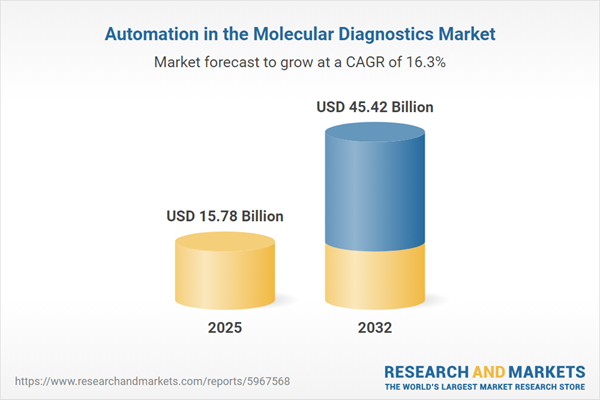Speak directly to the analyst to clarify any post sales queries you may have.
Automation in molecular diagnostics is redefining how senior leaders oversee laboratory operations. The latest solutions leverage technology to streamline workflows, enhance process accuracy, and support compliance within clinical and pharmaceutical contexts.
Market Snapshot: Automation in Molecular Diagnostics Market
The Automation in Molecular Diagnostics Market is advancing rapidly, currently valued at USD 13.54 billion in 2024. Growth projections estimate a rise to USD 15.78 billion by 2025 and further to USD 45.42 billion by 2032, reflecting a compound annual growth rate (CAGR) of 16.33%. This uptrend is driven by ongoing improvements in laboratory automation, increasing demand for diagnostic precision, and widespread adoption of integrated technology platforms. Laboratories today invest in scalable systems designed to boost sample throughput, improve data management, and simplify adherence to evolving regulatory obligations. Within an increasingly complex clinical and biopharma sector, automation in molecular diagnostics positions organizations to meet operational and quality benchmarks.
Scope & Segmentation: Automation in Molecular Diagnostics Market
- Product Types: Consumables and reagents, such as microarray chips, NGS library kits, and PCR kits, form the basis of diverse diagnostic workflows. Core instruments—microarray analyzers, next-generation sequencing (NGS) systems, and PCR platforms—anchor laboratory automation. Integrated software and managed services further empower laboratories to streamline and optimize processes.
- End Users: Automation supports a range of stakeholders including clinical laboratories, hospital labs, diagnostic centers, pharma and biotech firms, reference facilities, and research organizations. Each benefits from increased accuracy, faster turnaround, and improved organization in both clinical and investigative tasks.
- Technologies: Key molecular diagnostic platforms, including microarray, NGS, and PCR, address a broad span of routine and specialty testing needs. These technologies ensure laboratories meet technical, operational, and compliance expectations.
- Automation Levels: Laboratories can deploy fully automated, semi-automated, or walkaway systems. This flexibility enables organizations to match automation choices to staffing, budget, and evolving business requirements.
- Applications: Automated solutions are widely implemented in cardiovascular, genetic, oncology, infectious disease, and women’s health diagnostics. This facilitates timely, responsive clinical decisions across diverse healthcare domains.
- Regions: The Americas, Europe, Middle East, Africa, and Asia-Pacific reflect unique patterns of adoption shaped by regulatory mandates, funding, and infrastructure development. Regional factors influence both the pace and style of automation integration.
- Key Companies: Industry leaders such as F. Hoffmann-La Roche Ltd, Thermo Fisher Scientific Inc., Danaher Corporation, Abbott Laboratories, QIAGEN N.V., bioMérieux SA, Bio-Rad Laboratories, Siemens Healthineers AG, PerkinElmer, and Agilent Technologies deliver automation portfolios globally.
Key Takeaways for Senior Decision-Makers
- Laboratory automation limits manual tasks, leading to streamlined processes and improved reproducibility in multiple laboratory environments.
- Integrating robotics and informatics strengthens data reliability and enables actionable insights, critical for high-volume clinical and research testing.
- Modular automation allows organizations to scale solutions in line with their strategic goals and operational evolution.
- Purchases planned around regulatory requirements help maintain compliance and sustain process integrity throughout laboratory operations.
- Sustainability initiatives are supported by energy-efficient technologies and responsible consumables, linking operational efficiency with environmental objectives.
- Managed services, such as remote diagnostics and troubleshooting, free laboratory teams to focus on innovation and broader strategic activities.
Evaluating Tariff Impact on Supply Chains and Cost Structure
Forthcoming US tariffs anticipated in 2025 are prompting laboratories to adjust procurement and supply chain strategies. Many organizations are diversifying supplier relationships, increasing local sourcing, and refining inventory systems. By engaging vendors collaboratively and applying just-in-time inventory principles, leadership can reduce exposure to economic risk, reinforce overall supply chain resilience, and maintain steady laboratory operations despite fluctuating trade conditions.
Methodology & Data Sources
This report integrates direct insights from senior executives, expert commentary, and data from specialized literature and market analyses. Input from laboratory managers, procurement specialists, industry advisors, and R&D leaders grounds the findings in real-world operational and strategic experiences.
Why This Report Matters
- Equips leaders for strategic planning and quick adaptation by clarifying current laboratory automation trends and implementation strategies.
- Shows how regulatory, technical, and operational shifts shape leadership decisions, supporting better allocation of resources and risk management.
- Provides actionable guidance for enhancing compliance and optimizing workflow efficiency in diverse laboratory contexts.
Conclusion
Leveraging robust automation in molecular diagnostics, organizations reinforce their capabilities to manage regulatory demands, adapt to sector changes, and consistently deliver reliable laboratory performance.
Additional Product Information:
- Purchase of this report includes 1 year online access with quarterly updates.
- This report can be updated on request. Please contact our Customer Experience team using the Ask a Question widget on our website.
Table of Contents
3. Executive Summary
4. Market Overview
7. Cumulative Impact of Artificial Intelligence 2025
Companies Mentioned
The companies profiled in this Automation in the Molecular Diagnostics market report include:- F. Hoffmann-La Roche Ltd
- Thermo Fisher Scientific Inc.
- Danaher Corporation
- Abbott Laboratories
- QIAGEN N.V.
- bioMérieux SA
- Bio-Rad Laboratories, Inc.
- Siemens Healthineers AG
- PerkinElmer, Inc.
- Agilent Technologies, Inc.
Table Information
| Report Attribute | Details |
|---|---|
| No. of Pages | 192 |
| Published | November 2025 |
| Forecast Period | 2025 - 2032 |
| Estimated Market Value ( USD | $ 15.78 Billion |
| Forecasted Market Value ( USD | $ 45.42 Billion |
| Compound Annual Growth Rate | 16.3% |
| Regions Covered | Global |
| No. of Companies Mentioned | 11 |









